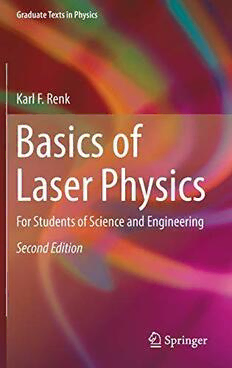
Basics of Laser Physics: For Students of Science and Engineering PDF
Preview Basics of Laser Physics: For Students of Science and Engineering
Graduate Texts in Physics Graduate Texts in Physics Graduate Texts in Physics publishes core learning/teaching material for graduate- and advanced-level undergraduate courses on topics of current and emerging fields within physics,bothpureandapplied.ThesetextbooksservestudentsattheMS-orPhD-leveland theirinstructorsascomprehensivesourcesofprinciples,definitions,derivations,experi- mentsandapplications(asrelevant)fortheirmasteryandteaching,respectively.Interna- tionalinscopeandrelevance,thetextbookscorrespondtocoursesyllabisufficientlytoserve asrequiredreading.Theirdidacticstyle,comprehensivenessandcoverageoffundamental materialalsomakethemsuitableasintroductionsorreferencesforscientistsentering,or requiringtimelyknowledgeof,aresearchfield. SeriesEditors ProfessorWilliamT.Rhodes FloridaAtlanticUniversity DepartmentofComputerandElectricalEngineeringandComputerScience ImagingScienceandTechnologyCenter 777GladesRoadSE,Room456 BocaRaton,FL33431,USA E-mail:[email protected] ProfessorH.EugeneStanley BostonUniversity CenterforPolymerStudies DepartmentofPhysics 590CommonwealthAvenue,Room204B Boston,MA02215,USA E-mail:[email protected] ProfessorRichardNeeds CavendishLaboratory JJThomsonAvenue CambridgeCB30HE,UK E-mail:[email protected] PleaseviewavailabletitlesinGraduateTextsinPhysicsonserieshomepage http://www.springer.com/series/8431/ Karl F. Renk Basics of Laser Physics For Students of Science and Engineering With333 Figures 123 ProfessorDr.KarlF.Renk Universita¨tRegensburg Institutfu¨rAngewandtePhysik,Universit¨atsstr.31 93053Regensburg,Germany E-mail:[email protected] ISSN1868-4513 e-ISSN1868-4521 ISBN978-3-642-23564-1 e-ISBN978-3-642-23565-8 DOI10.1007/978-3-642-23565-8 SpringerHeidelbergDordrechtLondonNewYork LibraryofCongressControlNumber: 2011945843 ©Springer-VerlagBerlinHeidelberg2012 This work is subject to copyright. All rights are reserved, whether the whole or part of the material is concerned,specificallytherightsoftranslation,reprinting,reuseofillustrations,recitation,broadcasting, reproductiononmicrofilmorinanyotherway,andstorageindatabanks.Duplicationofthispublicationor partsthereofispermittedonlyundertheprovisionsoftheGermanCopyrightLawofSeptember9,1965,in itscurrentversion,andpermissionforusemustalwaysbeobtainedfromSpringer.Violationsareliableto prosecutionundertheGermanCopyrightLaw. Theuseofgeneraldescriptivenames,registerednames,trademarks,etc.inthispublicationdoesnotimply, evenintheabsenceofaspecificstatement,thatsuchnamesareexemptfromtherelevantprotectivelawsand regulationsandthereforefreeforgeneraluse. Printedonacid-freepaper SpringerispartofSpringerScience+BusinessMedia(www.springer.com) To Marianne,Christiane,andPeter ’ Preface Thistextbookaddressesstudentsofscienceandengineering.Itshouldbeappropri- ateforaseniorlevelappliedphysicsorengineeringcourseonlasers. Therearemanytextbooksonlasers.Whymayitbeusefultohaveanotherone? I have tried to unify the description of different types of lasers: gas lasers; solid state lasers, including semiconductor lasers; dye lasers; and free-electron lasers. Semiconductorlasersaredescribedinmoredetailthaninothertextbooksonlasers. This may be adequate according to the very different types of semiconductor lasersandthemanydifferentapplications. What is the working principle of a laser and how is it realizable in different typesoflasers?Iintroducealaserasanoscillator(Dlaseroscillator)thatgenerates coherentradiationviatheinteractionofradiationwithanactivemedium.Anactive mediumconsistsofanensembleofatomicsystemswithapopulationinversion. I make use, on an elementary quantum mechanical basis, of the Einstein coefficients of absorption, spontaneous and stimulated emission of radiation to characterizetheinteractionofradiationwithanatomicsystem.Einsteincoefficients aredeterminablefromquantitiesthatareexperimentallyaccessible.Iformulatethe workingprincipleofa laserbytheuseofrateequations,yieldingtheconditionof laseroscillationandotherpropertiesofalaser. Themaintopicsofthebookconcern:theworkingprincipleofalaser;theparts of a laser — like the laser resonator and the active medium; beams of radiation generated by a laser; femtosecond laser pulses; and different types of lasers. Additionaltopicsdeepentheunderstandingofmorespecificquestionsconcerning, inparticular:originofgaininatitanium–sapphirelaser;opticalfrequencyanalyzer; theoryofgainofradiationindopedglassfibers. Itseemsthatanimportanttypeoflaser—thefree-electronlaser—doesnotmeet the criteria of a laser: classical physics is well suited to analyze operation a free- electronlaser.Iwill,nevertheless,illustrateoperationofafree-electronlaserbyuse of an energy-leveldescription. An active medium of a free-electronlaser consists of oscillating free electrons. I attribute, to an oscillating free electron, an energy- ladder system. In this description, population inversion occurs in an ensemble of vii viii Preface energy-laddersystems;theconceptisknownforaparticularsemiconductorlaser— the superlattice Bloch laser (also called Bloch oscillator) — that exists, however, onlyas an idea based on theoreticalwork.The energy-leveldescriptionillustrates similarities of free-electron lasers and conventional lasers as well as differences betweenthem. A chapter comparing laser oscillators and quasiclassical solid state oscillators providesaconnectiontotextbookscoveringthefieldofmicrowaveoscillators;addi- tionally,thevanderPoloscillatorisintroducedasamodelofaclassicaloscillator.In contrasttoalaser,withapopulationinversioninanensembleofquantumsystems,a quasiclassicaloscillatoroperateswithoutpopulationinversion:radiationinanactive mediuminteracts with collectivesof electrons— the interaction is determinedby classical physics but the ability to form appropriate collectives of electrons is of quantummechanicalnature. A reader may skip, in a first study, several chapters or sections that serve for deepening: Chap. 9 (dynamics of the active medium); Sect. 11.7 (Gouy phase); Sects.12.9, 12.10, 13.3–13.9 (laser applications); Chap. 17 (physical basis of broadband solid state lasers); Chap. 18 (theory of fiber lasers and amplifiers); Sects.19.5–19.12 (energy-level description of the free-electron laser); Chap. 21 (theory of semiconductor lasers); Sects.25.8–25.15 (theory of electromagnetic waves in layered materials); Chap. 26 (discussing quantum well lasers in detail); Chap. 30 (theory of electron waves in semiconductor heterostructures); Chap. 31 (comparing lasers with quasiclassical oscillators); Chap. 32 (Bloch laser); Chaps. 33–35 (laser-relatedtopics). Deepening of topics related to solid state physics (including semiconductor physics) corresponds to my experience in researchinsolidstatespectroscopy.Severalothertextbooksdeepenthediscussion oflasersmoretowardatomicphysicsorquantummechanics. Text illustrations, examples, and exercisesshould allow a studentto follow the mainlinebutalsosinglearguments. I wouldlike to thankthestudentswhoattendedmy“LaserPhysics” coursefor askingquestionsaboutafirstmanuscript.IthankAlfonsPenzkoferforexamininga largeportionofthemanuscriptandsuggestingmanyimprovements.Iamindebted to Al Sievers for very helpful advice with respect to manuscript and exercises. I appreciate many valuable comments from Laurence Eaves, Max Maier, Peter Renk, Jens Siewert, Benjamin Stahl, Herbert Welling, and Ernst Werner. I thank RupertHuber,JoachimKeller,TobiasKorn,JohnLupton,ChristophStrunk,Werner Wegscheider for discussions, and Peter Olbrich for advice on electronic data processing.UllaTurbahasdrawnalargepartofthefiguresandhaswrittenalarge partofthemanuscript.Iamverygratefulforherengagementduringpreparationof variousversionsofthemanuscriptandforallowingmetopermanentlychangetext, formula,anddrawings.IamindebtedtoClausAscheronforhisencouragementto writeabook. Regensburg,Germany KarlF.Renk September2011 Contents PartI GeneralDescriptionofaLaserandanExample 1 Introduction................................................................. 3 1.1 LaserandLightBulb ............................................... 3 1.2 SpectralRangesofLasersandListofaFewLasers.............. 4 1.3 LaserSafety......................................................... 6 1.4 SizesofLasers,CostofLasers,andLaserMarket................ 6 1.5 QuestionsAbouttheLaser ......................................... 8 1.6 DifferentTypesofLasersintheSameSpectralRange ........... 9 1.7 ConceptoftheBook................................................ 9 1.8 References........................................................... 11 1.9 ARemarkabouttheHistoryoftheLaser.......................... 11 Problems ..................................................................... 14 2 LaserPrinciple.............................................................. 17 2.1 ALaser.............................................................. 18 2.2 CoherentElectromagneticWave................................... 18 2.3 AnActiveMedium.................................................. 22 2.4 LaserResonator..................................................... 26 2.5 LaserDLaserOscillator ........................................... 31 2.6 RadiationFeedbackandThresholdCondition..................... 32 2.7 FrequencyofLaserOscillation..................................... 34 2.8 DataofLasers....................................................... 35 2.9 OscillationOnsetTime ............................................. 38 Problems ..................................................................... 39 3 Fabry–PerotResonator .................................................... 43 3.1 LaserResonatorsandLaserMirrors............................... 43 3.2 VFactorandRelatedQuantities ................................... 45 3.3 NumberofPhotonsinaResonatorMode ......................... 46 3.4 IdealMirror ......................................................... 47 3.5 Fabry–PerotInterferometer......................................... 48 ix x Contents 3.6 ResonanceCurveofaFabry–PerotResonator .................... 50 3.7 Fabry–PerotResonatorContainingaGainMedium .............. 52 Problems ..................................................................... 53 4 TheActiveMedium:EnergyLevelsandLineshapeFunctions........ 55 4.1 Two-LevelBasedandEnergy-LadderBasedLasers.............. 56 4.2 Four-Level,Three-Level,andTwo-LevelLasers.................. 57 4.3 Two-BandLaserandQuasibandLaser ............................ 59 4.4 Energy-LadderBasedLaser........................................ 61 4.5 Lineshape:HomogeneousandInhomogeneous LineBroadening .................................................... 61 4.6 LorentzFunctions................................................... 63 4.7 GaussianLineshapeFunction...................................... 66 4.8 ExperimentalLinewidths........................................... 67 4.9 ClassicalOscillatorModelofanAtom............................ 68 4.10 NaturalLineBroadening ........................................... 70 4.11 EnergyandPhaseRelaxation ...................................... 70 4.12 Three-DimensionalandLow-Dimensional ActiveMedia........................................................ 71 Problems ..................................................................... 72 5 Titanium–SapphireLaser ................................................. 75 5.1 PrincipleoftheTitanium–SapphireLaser......................... 75 5.2 DesignofaTitanium–SapphireLaser ............................. 77 5.3 AbsorptionandFluorescenceSpectraofTitanium–Sapphire..... 78 5.4 PopulationoftheUpperLaserLevel............................... 79 5.5 HeatandPhonons................................................... 80 Problems ..................................................................... 80 PartII TheoreticalBasisoftheLaser 6 BasisoftheTheoryoftheLaser:TheEinsteinCoefficients........... 83 6.1 LightandAtomsinaCavity ....................................... 83 6.2 SpontaneousEmission.............................................. 85 6.3 Absorption .......................................................... 86 6.4 StimulatedEmission................................................ 86 6.5 TheEinsteinRelations.............................................. 86 6.6 EinsteinCoefficientsontheEnergyScale......................... 89 6.7 StimulatedVersusSpontaneousEmission......................... 90 6.8 DeterminationofEinsteinCoefficientsfromWaveFunctions.... 92 Problems ..................................................................... 93 7 AmplificationofCoherentRadiation..................................... 95 7.1 InteractionofMonochromaticRadiationwithan EnsembleofTwo-LevelSystems .................................. 96 7.2 GrowthandGainCoefficient....................................... 98 7.3 GainCrossSection.................................................. 101
